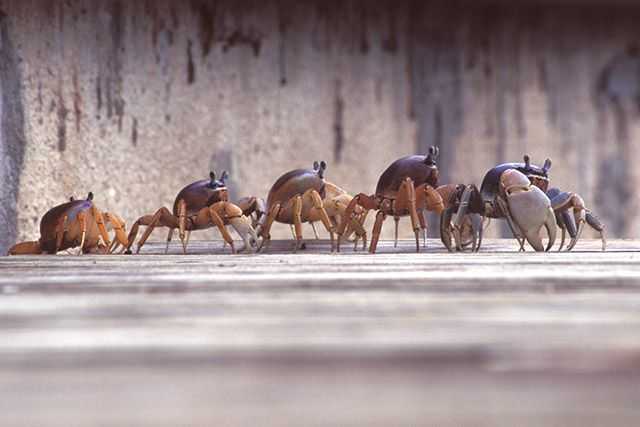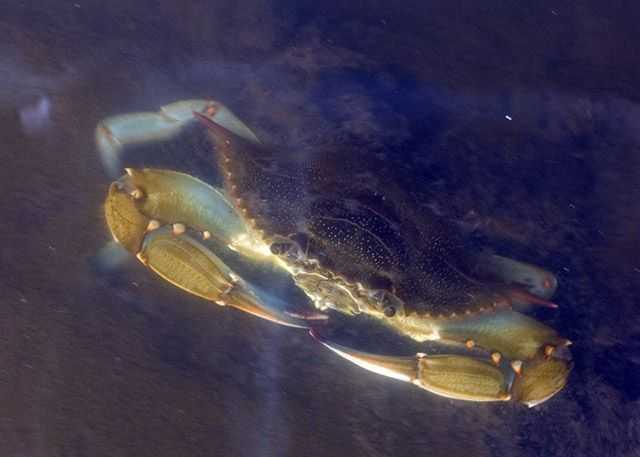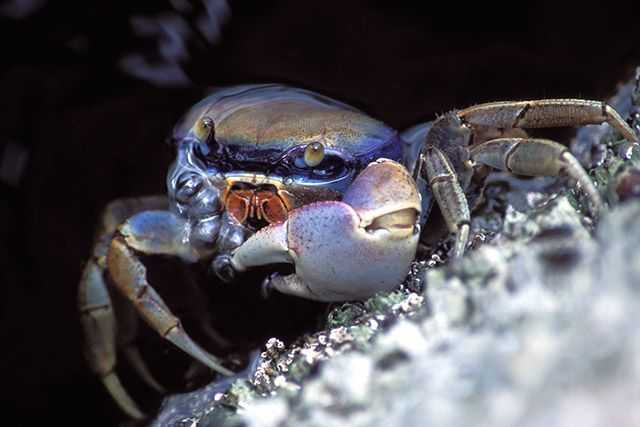
[dropcap]T[/dropcap]here are two big crabs that are blue and commonly found in and around Florida’s estuaries and they are both delicious. The blue crab (Callinectes sapidus), at up to nine inches wide, is a valuable scavenger as are most crab species. It has been harvested up and down the east coast since the mid-1800s. The other is the blue land crab (Cardisoma guanhumi) with a ponderous carapace that can grow greater than four inches wide. This one spends most of its life not in the estuarine water but next to it and has a long history of harvest in the Caribbean. It has only been since the end of the last century that harvesting began to take its toll on the populations in the United States prompting regulations to be put in place.

The blue land crab can be found up to three miles from the ocean, but it would be a stretch to label them “terrestrial”. However they are not exactly aquatic either. They are more like amphibians in that they are able to absorb more oxygen from moist air than directly from water. Their modified gills allow them to live in low elevations, generally where the water table is no deeper than six feet. Here they dig burrows deep enough to be semi-flooded by ground water seepage. The water, which can be either fresh or brackish, keeps the air humid inside the burrow while allowing for the occasional “crab dip” to build-up moisture reserves. They are normally nocturnal or venture out to eat only at dawn or dusk when the air is more humid and there is less chance of getting baked by the sun.

There are two times of year when blue land crabs are noticeably out and about above ground, and this is most evident to motorists whose tires are occasionally punctured by accidently running them over. The first is at the onset of the wet season in late spring with male and female, young and old, participating. This movement is no doubt related to an increase in water level in the burrows, which may be their first sign that the season has changed. It is generally believed that during this time the animals, sometimes described as vegetarians even though opportunistic is more accurate, are searching for productive feeding grounds. It is also during this time that healthy adults mate.

The second time period is more akin to a migration and peaks in October and November. It coincides with the high tides of fall that occur due to high water temperature and favorable wind direction and is further enhanced by the full moon. The females that live up to three miles from the coast are impelled to travel to the ocean over wetlands, dunes and unfortunately roads. Once at the shoreline, with agitated splashing, they wash approximately half a million eggs from the outside of their body where they have been carried for nearly two weeks following fertilization. At this time of year the stronger tides may play a role in the wide dispersal of their eggs and larvae which come ashore as baby crabs in just over a month.

Depositing their eggs is typically staggered depending on the maturity of their eggs and the timing of the full moon, however catastrophic tides such as occur during tropical storm events can cause a mass exodus from the burrows making the ground and roads look like they are crawling with crabs. It is believed that even with the widespread dispersal made possible by the turbulent water, survival of the larvae in these events is in the single digit percentages, partially caused by the low salinity of torrential rain events. Studies have shown that eggs deposited in ocean water diluted by too much fresh water runoff will not survive even though the adults can tolerate low or even no salinity.

The popularity of land crabs as a tasty meal and the loss of habitat to development have significantly impacted their population numbers. The practice of catching them just as they are heading to deposit their eggs in the ocean, the worst time to harvest, has increased to the point that it has prompted the Florida Fish & Wildlife Commission to issue a set of rules to protect these colorful crabs during their most vulnerable period (see http://myfwc.com/fishing/saltwater/recreational/blue-land-crabs/.) They are now protected between July 1 and October 31st and there are daily bag limits. Likewise get familiar with blue crab regulations, harvesting egg-bearing females is also prohibited (see http://myfwc.com/fishing/saltwater/recreational/blue-crab/.) Our appetite for tasty seafood is boundless but recognizing the value and role of these animals and practicing wise harvesting principles is what makes us good stewards of this beautiful place we call home.
Ellie Van Os is Director of Education and Exhibits for the Florida Oceanographic Society. She can be contacted at evanos@floridaocean.org and by phone at (772) 225-0505 ext. 113.